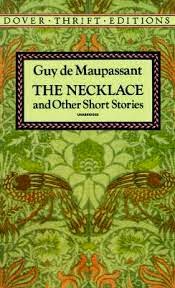“C’etait une de ces jolies et charmantes filles, nées, comme par une erreur du destin, dans une famille d’employés.”
Yes, she certainly was a pretty and charming girl who was born by a mistake of destiny into a family of office workers. Mathilde would dream of riches and fame and jewels, covering her life of drudgery in a tapestry of fantasies and longings. Finally, one day, her husband arrives with an invitation to a party. Mathilde manipulates this honest, hard-working man into purchasing a new elegant dress for her, but when she complains of a lack of jewels, he has the answer: borrow some from her wealthy friend Madame Forestier! A lovely diamond necklace of Madame’s catches Mathilde’s eye and she must have it. Her friend, generous to the end, gladly loans it and the evening of her dreams begins. She is admired, she is catered to, she is wrapped in a heavenly realm of blissful wealth and prestige. Late do she and her husband return home, reluctant to leave the party until the end but, oh no! The necklace has disappeared and she is sure that she left it in the taxi. Days of searching yield nothing and finally there is only one thing to do. Withdrawing their life savings and taking out a loan, they replace the necklace, hoping that Madame will not notice. But this painful action causes them ten years of needless toil and suffering. Why is it needless? Well, you will have to read the tale to find out!
This short story was really a gem and, in spite of having an inkling of the final twist, it still held my attention to end. In fact, I had expected to get fatigued by reading such a long (for me) story in French and I had planned to take a break, but instead, I was held rapt until the end.
I did wonder at the title of this story. In the tale, the necklace is mostly referred to as “la rivière“, yet the title is “la parure“. When I looked up “la rivière” in my French dictionary it says “river“, and “la parure“means “finery” or “jewelry“. So then I looked up necklace and it had “le collier“. What? Do any of you Francophiles understand the distinction between these terms? Help!
In any case, this story has definitely been a huge incentive to read more of Maupassant. His short stories are very readable and a good way to keep improving my French. I certainly struggled here and there in parts of it and learned a number of new words, yet I was also pleased with my progress.
This will probably be the last book for my Summer Freak Language Challenge, unless I can squeak in a short children’s book before the end. Thanks Ekaterina, for holding this wonderful challenge. It’s given me a chance to practice languages that I wouldn’t normally read in. I’m already looking forward to next year’s challenge!



